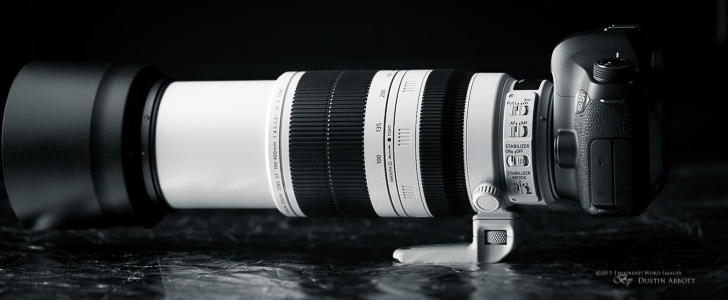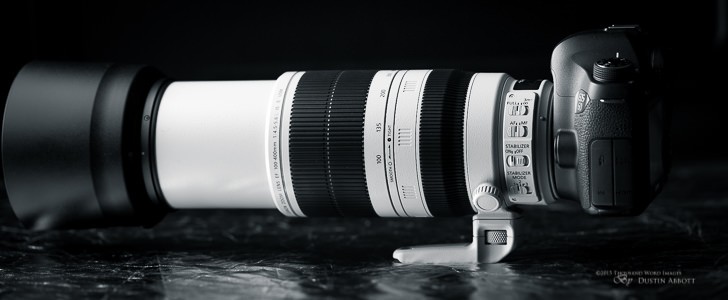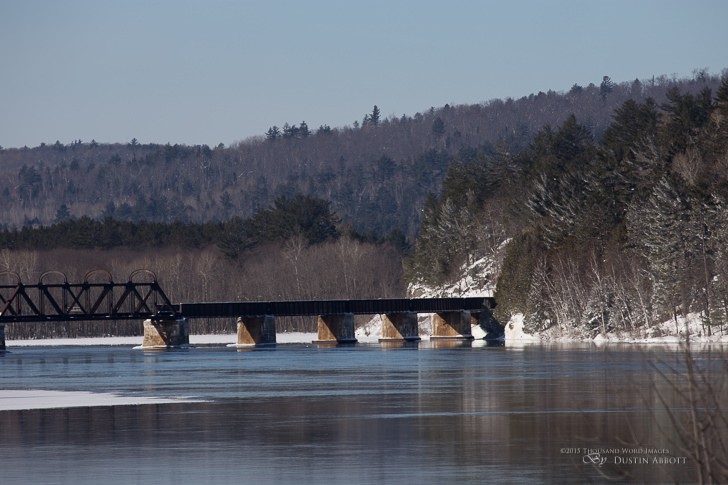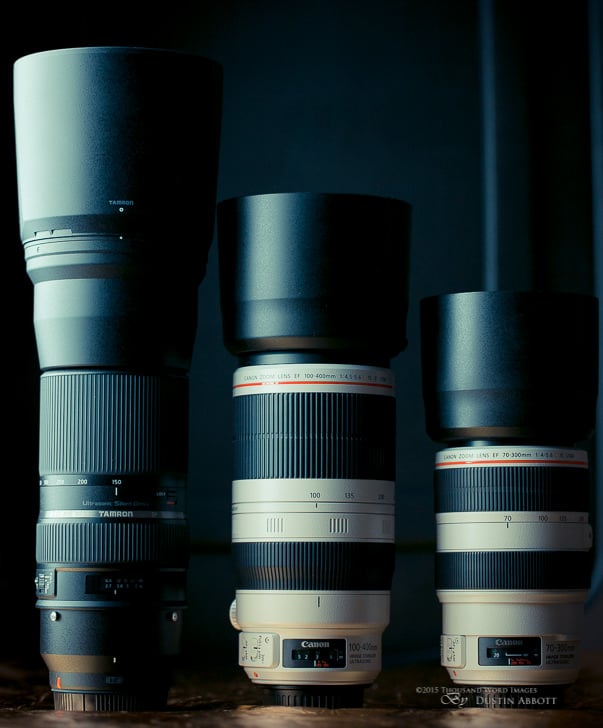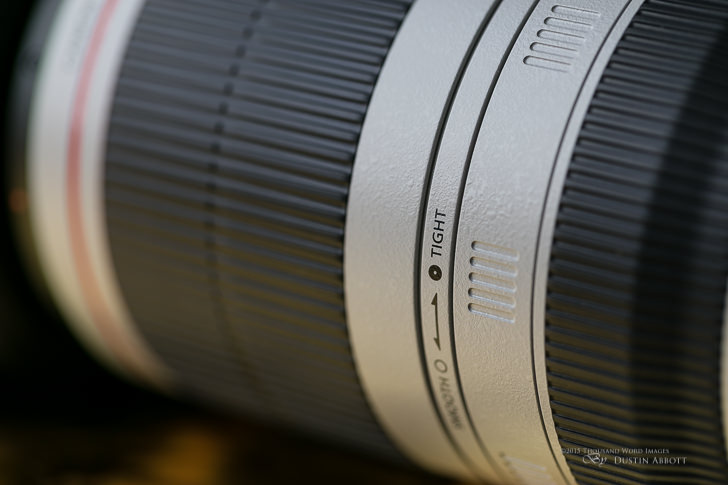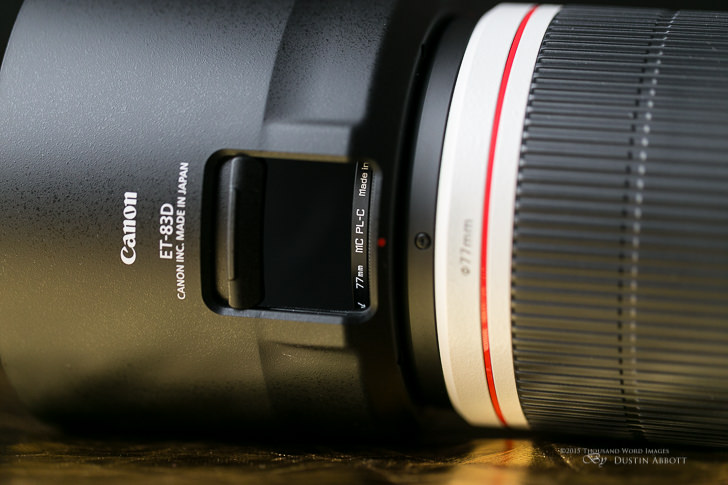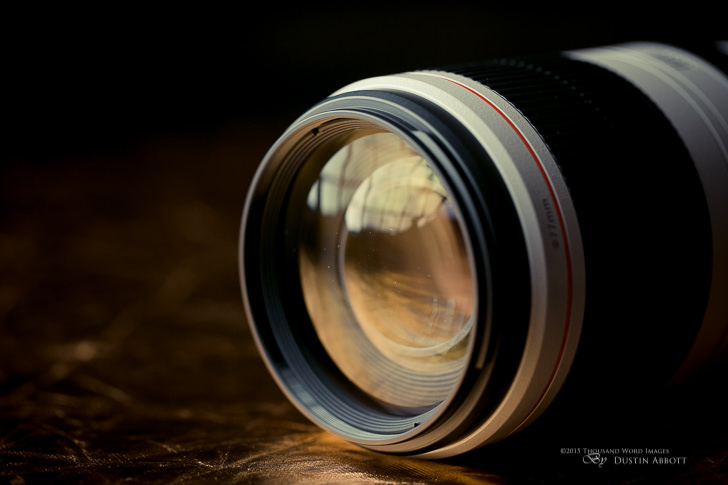Review – Canon EF 100-400mm f/4.5-5.6L IS II
By: Dustin Abbott – WWW | Facebook | YouTube
Discuss the Canon EF 100-400mm f/4.5-5.6L IS II Review
Great First Impressions
This lens has been referred to as “the unicorn” in various internet forums because it has been long rumored but never seen “in the wild”. But it has finally arrived, and my time with this excellent telephoto lens has shown me that Canon has done its homework and produced an exceptionally good lens. Before proceeding, let me give you quick timeline. I began reviewing the lens at the beginning of 2015, and really liked it, though I also liked my existing telephoto kit of the Canon 70-300L + the Tamron 150-600mm. I had also yet to review the new Sigma 150-600 Sport and Contemporary lenses, which I subsequently did. After spending time with all of the new super telephoto zooms (not including the incredible and incredibly expensive 200-400 f/4L IS), I ultimately elected to sell the 70-300L and Tamron and add the 100-400L II to my personal kit. I'll come back to this in the summation. If you want to see more larger images and more comparison crops, take a look at the review on my website here.
The good impressions come from the moment that you begin to unpack the lens. It comes in a large box and is extremely well protected. It has a very nice padded case with straps for carry (why again did the 70-300L NOT come with one of these?), and the lens was very well protected inside this case.
The first generation of this lens had a somewhat polarizing push/pull design that Canon has wisely elected to abandon in the second generation. There are some photographers who love the push/pull design, but a good number of others hate it. Very few lenses employ the push/pull design, so Canon should marginalize fewer photographers by going with a more traditional twist zoom design with this lens. The design ethos most closely resembles the design of the 70-300L with a similarly dense feel, thickness, lens color, and single barrel extension. The new 100-400L incorporates a number of smart little new design features that really elevate this lens above the ordinary and right to the head of the class.
When I pulled the lens out, I immediately liked it. I like the design, the way that small details are implemented, the highly intelligent design of the lens hood with a little window for adjusting a polarizing filter (smart!!). I liked the feel of the lens in my hands, the balance and weight of it. I found it surprisingly compact. I also like the design of the tripod collar. I have a bit of a love/hate affair with tripod collars. I don’t often use tripods, and so if a collar is removable, it will be removed. If you primarily handhold lenses (like I do), tripod collars add weight and bulk. The bad news here is that the tripod collar is not completely removable, but it is designed to minimize weight and bulk. The actual “foot” IS removable, (its design actually reminds me of Canon’s design of the EF adapter for the EOS M system) and the remainder of the collar can easily be rotated out of the way. That foot is compact enough to be easily packed along for the moments when you might want to use a monopod/tripod. The 70-300L did not come with a tripod collar, but its smaller weight and bulk precludes the need of one in my experience. This lens is heavier than the 70-300L, but it is still not a difficult lens to handhold thanks to good balance and an excellent stabilizer (more on that in a moment).
This is an excellent focal length. Nikon offers an 80-400mm lens, which is an even better focal length, but the Nikkor decisively loses in the image quality department when compared to this lens. This quick visual comparison shows the framing difference between 100mm and 400mm:
The Canon 100-400L II finds a very good balance between build quality and portability. Roger Cicala from LensRentals has done a breakdown of the internals of this lens and concluded that it is the best and most heavily engineered zoom lens they have ever seen. That is a huge compliment! It is not a small lens and weighs in at 55.4oz/1570g. This is marginally heavier than the MK I version of the lens (1380g) but comes in quite a bit under the Tamron 150-600 VC’s weight of 1950g. The new Sigma 150-600 Sport OS lens is in a completely different weight class at right under 3000g. The weight of the Canon 100-400L II is roughly comparable to that of Canon’s 70-200 f/2.8L zoom lens, so, in other words, very manageable for most users. Its retracted length is actually about 6mm shorter than the 70-200L, although unlike that lens the barrel of the 100-400L will extend significantly when zoomed to its 400mm length. The Canon’s retracted length (without the hood attached) is 7.6”/193mm). This is a significant advantage over the Tamron 150-600 VC, which has a retracted length (also without hood) of 10.1”/257.8mm, as I am able to carry it in my Lowepro backpack in the upper compartment on its side while mounted to my 6D body. The Tamron requires me to open both compartments and top mount the camera/lens combo, which result both in less stability and obviously less room to store other gear. Put simply, this lens is going to be a friend to those who plan to travel with it, providing them very nice reach (particularly when used with an extender) in a reasonably compact body.
I really, really like the execution of the zoom lock on this lens. Rather than a switch it employs a ring after the focus ring that allows you to rotate the ring between “Smooth” and “Tight”. Smooth simply means normal zoom action, which is very easy and nicely damped. At the extreme of the “Tight” position the ring acts as a zoom lock, preventing zoom creep from the pull of gravity. I often carry teles in either a Black Rapid strap system or a chest harness; both involve the lens facing down and invite zoom creep. The system on the lens is very effective at preventing this. But I find it a big improvement over the typical zoom lock switch for a few reasons. First of all, the design is very easy to use while wearing gloves. Since I live in Canada this is a big deal. The whole process of either setting it or releasing it is also far more intuitive as a part of raising the lens and shooting. It quickly became second nature as the step right before zooming. Also, even at its tightest setting, you can still zoom the lens in a critical situation, so you should never lose a shot because the zoom lock was set again. Finally, it allows you to set the “lock” at any focal length, and there may be a situation where 300mm, for example, is the range that you want to shoot at. This lock can keep the zoom set there so it is instantly ready to shoot even if you are moving in between shots. I think this is a great bit of design.
The lens hood features a new design that includes a small window in the side that can slide open to allow a person to easily adjust a circular polarizing filter without trying to reach down the hood to get at the filter. It’s such clever, intuitive design that you wonder why someone didn’t think of it sooner! It’s a really smart feature, particularly considering that telephoto lenses tend to have very deep hoods.
One final nice touch is that this lens has retained a very modest 77mm front filter thread. The cost of 77mm filters is fairly reasonable, and it has been such a common filter size that it likely that many people will have a few in their collection already. The Tamron 150-600 VC sports a 95mm front filter thread, while the new Sigma 150-600 Sport lens has a gargantuan 105mm front filter thread. These lenses also have an additional 200mm of reach, of course, but that is somewhat mitigated by the fact that the new Canon has been designed to work far better with extenders than its predecessors.
Designed for Use with Extenders…maybe
One of the talking points about this new lens is that it is designed with Canon’s extenders in mind. Particularly a 1.4x extender, which changes the focal length to a 140-560mm lens with a maximum aperture of f/8 on the long end. That revised focal length allows it to compete more directly with the very popular 150-600mm variants from Tamron and Sigma. That’s great if you happen to own one of the Canon’s body that will autofocus with one of Canon’s extenders at f/8 (1Dx, 5DMKIII, 7DII). With any other Canon body, however, you may just be out of luck, as I am with my 6D or 70D bodies. I do own a Canon 1.4x extender, but I am only able to use it with my camera bodies in Live View focus (which is, by the way, painfully slow with this combination – the 70D's DPAF is somewhat better but still slow on the long end). On the upside, the image quality even with the extender in place remains strong. If you have a body that allows for AF with a Canon extender you also have the very nice option to do a second AFMA adjustment with the extender to ensure the best AF accuracy.
Fortunately the same Kenko 1.4x extender (Kenko Teleplus Pro 300 DGX) that I’ve used with other lenses in other reviews (Tamron 150-600 and Canon 70-300L– click links to read reviews) also works perfectly with this lens. In use the Kenko works very nicely with the new 100-400L II with the focus continuing to be fast and accurate. The Kenko has a few quirks (that make it work!), including the fact that while the camera continues to record the maximum aperture as being f/5.6 on the long end it is in fact now f/8. The camera continues to meter perfectly despite this little bit of digital trickery, but just know that your EXIF data in these settings will be incorrect. If you miss focus, the lens will hunt for a millisecond longer, but it is still effective. I would expect focus to be better still with a Canon extender on a body that continues to AF at f/8. Lens sharpness is still very good, however, and the bokeh also still looks good (extenders can do funny things to bokeh sometimes!).
Rock Steady
The predecessor of this new lens has continued to be popular throughout it’s fairly long run (it was introduced back in 1998, so a 16+ year production run is pretty sweet!) The MK 1 lens is still being sold alongside this new lens at the moment, so that run may continue a bit longer. The lens has continued to sell well despite some notable shortcomings because it provides entry into a fairly long focal length at a somewhat affordable price (at $1699 it is about $500 cheaper than the MK II version). One of those shortcomings was a dated image stabilizer system that offered about two stops of assistance. That’s better than nothing, obviously, but effective stabilizers become increasingly important as the focal length increases. Canon strongly ups the ante here with a modern stabilizer that provides a rated 4 stops of assistance but does perhaps even better in the field. This is particularly handy when you add an extender into the equation and the effective focal length becomes even longer (or use it on a crop sensor body).
The show below was captured at 400mm and 1/13th of a second – it is perfectly sharp – the IS just WORKS on this lens.
It bears repeating that image stabilization will NOT stop the movement of your subject, and longer focal lengths really exaggerate motion blur. If you are shooting moving subjects no image stabilization system will produce sharp images at low shutter speeds. Get that shutter speed up unless your subject is very still. The IS implementation here is very quiet. Quiet enough, in fact, that I cannot hear it even with my ear against it in a room with ambient noise. In an otherwise silent room I can hear it, but only if I put my ear next to the lens and purposefully listen for it.
The stabilizer system also offers three different modes (1, 2, and 3). 1 is the standard mode, and probably where many users will leave it. 2 is the mode for panning, as it turns off one axis of stabilization to allow the lens to move smoothly from side to side. The 3rd mode is intriguing, as it will only engage stabilization during exposure. Some photographers that use very high shutter speeds to stop motion will often turn off image stabilization systems because they can interfere with tracking and can cause erratic viewfinder behavior. If this is you, Mode 3 is your choice, because it acts as if it weren’t on until you actually engage the shutter, and then it will help to eliminate camera shake from the equation.
Focus Observations
Other than the two switches for the stabilizer there is also an AF/MF switch for focus (the lens’ USM [Ultrasonic Motor] allows for full time manual override at any point, of course) and a focus limiter switch. The latter allows you to choose between the full range of focus or to limit that range from 3 meters (about 10 feet) to infinity. This raises two important discussions.
First of all, the autofocus in the lens is very good. It is fast and accurate. It rarely hesitates before achieving focus lock. Focus feels near instantaneous most of the time, and the stronger AF system on my 70D produces even faster focus than on my 6D. The only time that focus feels slower is if the lens is focused towards minimum focus distance; it has to run through MUCH more of a focus range than the Tamron or Sigma equivalents that have a minimum focus distance about three times further than the Canon. If you are in a situation where you don't need that close minimum focus distance it is advisable to use the focus limiter switch as a focus miss will otherwise then cycle through a BIG range of additional (unneeded) focus.
The lens also performs well with AF Servo tracking, although, unsurprisingly, that effectiveness is slightly diminished when using an extender but the lens continues to perform quite strongly here. This series with my dog in high speed running towards the camera are my standard “stress test” for lenses and the lens did an able job despite dealing with the high contrast snowy scene.
One area where the lens does not shine is in poor lighting conditions. Focus slows down significantly, though the lens eventually locks accurate focus. This is one area where I felt the 70-300L performed better, and, of course, my 70-200mm f/2.8 performs better still. If your primary purpose is shooting indoor sports with somewhat poor lighting you may want to look elsewhere.
This lens has a unique strength for this type of telephoto. Many telephoto lenses have unimpressive minimum focusing distances, and accompanying low maximum magnification values. The bigger issue, however, is that sometimes wildlife or bird shooters encounter situations in the field where the bird or wildlife actually comes closer to them than their lens can actually focus. Those missed moments can be incredibly frustrating. It is not unusual to see a minimum focus distance of 3m (10 feet) or even longer. Even the Tamron 150-600 has a minimum focus distance of right under 9 feet. The new 100-400L has an amazing minimum focus distance of less than a meter (3.5 feet), meaning that you will almost never miss a shot because your subject is too close again! Furthermore, it achieves a maximum magnification of around .31x, which is close to 1/3rd life size, a figure rarely seen outside of a true macro lens. I can think of any number of useful purposes for that, and even more impressively the lens continues to resolve well at minimum focus. The great working distance (3.5 feet) and the long focal length means that blowing out backgrounds (even relatively close ones) is very easy, leading to some great looking shots. Note also that the use of either extenders or extension tubes will enable even more magnification, so it is certainly a factor to consider in the price. You are getting enough “macro” performance to satisfy a lot of photographers, particularly with the options above. Just switch over to the full focus range when you need to shoot close distances.
When I did a side by side comparison of AF speed with the Tamron 150-600 VC, I noticed that when the lens was defocused towards the minimum focus distance it took a little longer to focus than the Tamron. This is not surprising, as it has a tremendous amount of additional focus points because of that very close minimum focus distance. This highlights the particular importance of properly using the focus limiter.
This video examines the AF performance in much greater detail.
I was personally surprised to find how well the Tamron's AF speed held up by comparison. In fact, my time spent with all four of these lenses this year (100-400L II, Tamron 150-600, Sigma 150-600 S and C) demonstrated to me how blessed we are to have great reasonably affordable telephoto lenses. There really isn't a bad choice among them.
Image Quality
Opinions on the image quality of the original 100-400L vary from person to person. People have varying standards, of course, and it does appear that there was a significant amount of sample variation. There is a strong consensus that this new lens improves on the image quality of its predecessor in just about every way. It is true in the center, but even truer as you head out towards the periphery of the image circle. It stands head and shoulders above the MK 1 at the most important position of 400mm. It has a demonstratively superior performance with a 1.4x extender attached as well, meaning that the 560mm reach it can achieve is very useful. It favorably compares to the bare Tamron and Sigma lenses even with an extender. I have been very impressed with the image quality in every situation I have used it in. It achieves prime-like sharpness at most focal lengths, and furthermore it exhibits next to no optical shortcomings. Take a look at this crop from a wide open portrait.
It also gives an excellent performance near minimum focus distance.
It exhibits no real chromatic aberrations or fringing in field use, and continues that excellent performance even with a 1.4x extender attached (there will be marginally more CA, but nothing really to be concerned about). The vignetting is mild, and what exists is easily correctable either in camera or post processing. Vignetting moderately increases as you go deeper into the zoom range, but at no point is it any greater than 1.5 stops in the extreme corners. It seems to handle flare quite well, and while I did notice a bit of ghosting at times I was easily able to position the main ghosting pattern out of the frame.
Over its native focal length I would give the advantage to the Canon over the Tamron and Sigma variants in overall sharpness, particularly towards the periphery of the image. The Canon 70-300L might have a mild advantage on the wide end but is mildly eclipsed by the 100-400L on the long end. Put simply, I seriously doubt that anyone is going to be disappointed by the optical performance of this new lens. There is, put simply, nothing to complain about. I love it!
Lens distortion is minor, with a bit of barrel distortion on the wide end and an almost imperceptible trace of pincushion distortion on the long end. This is not going to be an issue. Even the bokeh looks pretty nice to my eye, with none of the “nervousness” that cheaper telephotos often exhibit. Canon knocked this one out of the park!
Multipurpose Lens
The versatility of this lens means that you can use it for a lot of different subjects. Long telephotos often feel a bit confining; they tend to be one trick ponies. But that simply isn't true of the 100-400L II. It focuses far more closely than competitors, it is more compact and thus easier to bring along, is more intelligently designed, and is thus a more flexible tool than most of its competitors. It works well for a huge diversity of subjects. Here are just a few of the things that I've enjoyed shooting with this lens over the past few months.
If you want to see many more images, check out the image gallery here.
In short, the great image quality, reasonable size and heft, strong autofocus performance, and amazing minimum focus means that there is very little that this lens cannot do. Its flexibility is a big part of its appeal to me.
Conclusions
I’m not finding much to criticize with this lens. It isn’t cheap, but it is a pretty killer optic with a pro grade build quality. It’s expensive ($2199), but no more so than Canon’s 70-200 f/2.8L or 24-70 f/2.8L variants. When compared with the higher end telephotos, however, it is a great bargain. It offers great reach in a compact package that most users should be able to handhold due to its manageable weight and excellent image stabilizer. It has amazing image quality with next to no real shortcomings. I liked it well enough that I sold two other lenses and added it to my kit instead. Congratulations to Canon for producing a lens full of innovation, toughness, and quality. Telephotos lenses are often restrictive lenses in the sense that their size, weight, and minimum focus distance limit the kinds of things that you can do with them. I don't personally feel that the 100-400L MKII suffers from any of those restraints. If I could put it this way, this lens feels less like a telephoto and more like a multipurpose lens that just happens to have more reach than any other multipurpose lens in your bag.
Purchase Options:
Pros:
- Excellent, robust build quality with weathersealing
- Strong optical performance throughout the focal range that rivals prime lenses
- Outstanding IS system that is both flexible, mannerly, and exceeds rating
- Innovative designs in the lens hood, tripod collar, and zoom lock
- 77mm filter size
- Superior minimum focus distance and maximum magnification figures
- Excellent performance with extenders* (provided you have the right camera body)
- Fast, highly accurate AF system
- Nice case included
- Three Stabilizer modes gives added flexibility
- Zoom lock easy to use when wearing gloves
Cons:
- Price tag is fairly high compared to competition (Tamron and Sigma C) and $500 premium over MK1 (though cheaper than the Nikon 80-400mm)
- Lens with Canon extender will only AF on select bodies
- AF system slows dramatically in low light situations
Notes: I have now reviewed/owned two retail copies of the lens and found them both to be consistently excellent.
Compared with the Tamron 150-600mm VC
In this video I break down the strengths and weaknesses of the lenses and compare them side by side.
Pros:
- Superior build quality
- Slightly faster AF and better AF Servo quality
- Somewhat better image quality, particularly toward the edges
- Store more compactly
- More Stabilizer Modes
- Much smaller filter thread (77mm vs. 95mm)
- Much better minimum focus distance (.98m vs. 2.7m)
- Better maximum magnification
- Better hood design
- Includes case
Cons:
- Higher price (plus the cost of an extender if you want longer reach and don’t own one).
- Smaller zoom range
- Requires extenders to reach somewhat similar focal length
- Will not AF on most camera bodies with a Canon extender attached
- Slower aperture speed when combined with extender
- Tripod collar not completely removable
Compared with the Canon 70-300L
Pros:
- Longer Reach
- Includes tripod collar and protective bag
- Marginally better optics at end of telephoto range
- Designed to work with extenders
- More Stabilizer Modes
- Better lens hood design
- Better maximum magnification
- Better IS performance
Cons:
- More expensive
- Larger size (cannot stand upright in camera bag)
- Slightly slower aperture at wide end
- AF performance slightly slower in dim lighting
Compared with the Canon 100-400L MK 1
Pros:
- Noticeably superior optical performance
- Much better image stabilization
- Less polarizing twist zoom vs. push-pull design
- Much better performance with extenders
- More accurate AF
- More stabilizer modes
- Better lens hood design and zoom lock
- Closer minimum focus and maximum magnifcation
Cons:
- Higher price tag
- Some prefer the push-pull design

